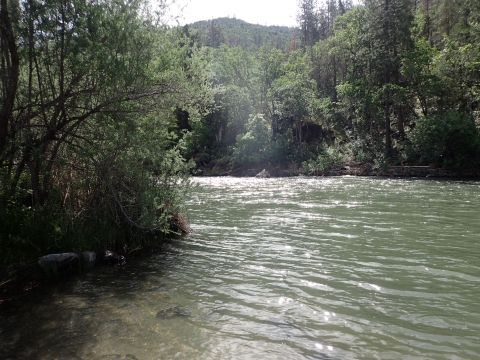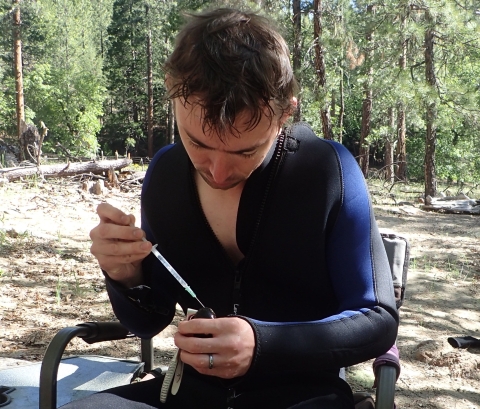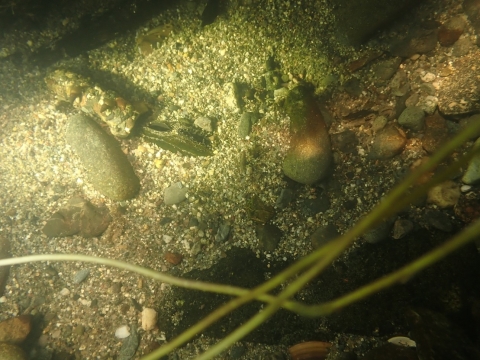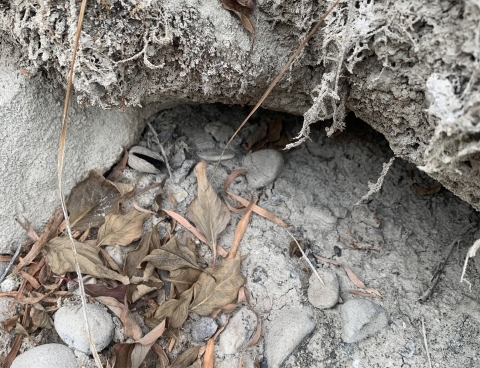Alex Jones, biologist with the U.S. Fish and Wildlife Service regional office in Sacramento probably didn’t realize what a workout his muscles would get by searching for, what else, mussels this past summer.
Jones, along with Supervisory Fish Biologist Josh Boyce of the Arcata field office and Emilie Blevins, the freshwater mussel conservation lead for Xerces Society, channeled their inner mussel – and flexed their own muscles – to snorkel sites on the Scott, Shasta, Trinity, and Klamath Rivers surveying for these freshwater mollusks.
In addition to muscle power, the team leveraged their combined knowledge of specific areas within the Klamath Basin to identify sampling locations with help from a Xerces Society database of historical mussel bed sites.
Jones said this survey will help fill gaps in the known information for California’s native freshwater mussels as part of a larger, nationwide collaborative project led by the Service. The goal is to develop condition status assessment tools to determine the health and abundance of freshwater mussels.
“We used two methods for this survey: snorkeling to visually document mussel beds and collecting samples from individual animals – hemolymph which is similar to human blood, and tissue,” said Jones. “This is the first time the Service has collected mussel hemolymph in our region. This analysis will help us assess the health, nutrition, physiology, and overall condition of mussels.”
Snorkeling is hard work in a normal water year but during a drought it can present with a new set of challenges such as calmer, shallow water and exposed, slippery algae-covered rocks. Add to that the mussels are very cryptic, meaning they do a pretty good job of hiding in the sandy stream bottoms.
“One of the major challenges I have on these surveys is that the animal itself looks like an actual rock,” said Jones. “It can be very hard to tell a rock from a mussel until you are practically on top of it. On the Klamath this year it was even more difficult because of the cloudy water.”
North America is home to the world’s highest biodiversity of freshwater mussels, and many of these species are listed as threatened or endangered. In the West, mussel populations are threatened by habitat modification, water quality and quantity issues, and declines in host fish species. In Southern California, native mussel species have experienced drastic declines and are now absent from much of their historic range.
The life and death of mussels is difficult to understand and often mysterious. Mussels can be in decline for months or years while displaying no indication of stress or poor health. Unlike fish, the signs of a healthy or unhealthy mussel are not obvious other than when it’s too late. Unfortunately, researchers are observing more dead mussel beds, masses of white shells appearing like underwater cemeteries.
“We are trying to answer the questions of what makes a healthy mussel and if mussels in our region are in fact healthy,” Jones said. “The project also provides us the opportunity to survey sites to determine if mussels are present which is important since data is lacking in California.”
Blevins, Xerces Society senior endangered species biologist agreed that it is important to expand research and monitoring efforts to ensure mussels are recognized and protected for all the benefits they provide to aquatic habitats.
“Freshwater mussels act like Brita filters, taking in water and purifying it through filtration. The volume of water filtered by a single mussel varies by species and the total number of mussels in an area, but it’s estimated they clean between 10 and 20 gallons of water a day,” Blevins said.
Mussels also can provide physical structure and habitat for other aquatic animals and are important to cycling and storing nutrients in river systems.
“By documenting native freshwater mussels, we have the opportunity to inform future conservation and restoration efforts and provide important guidance to biologists and land and water managers,” said Blevins. “Xerces will continue to work closely with the Service to conduct this important research. Together, we can ensure we recognize the incredible contributions of our native freshwater mussels and adequately account for their importance in our ecosystems.”








